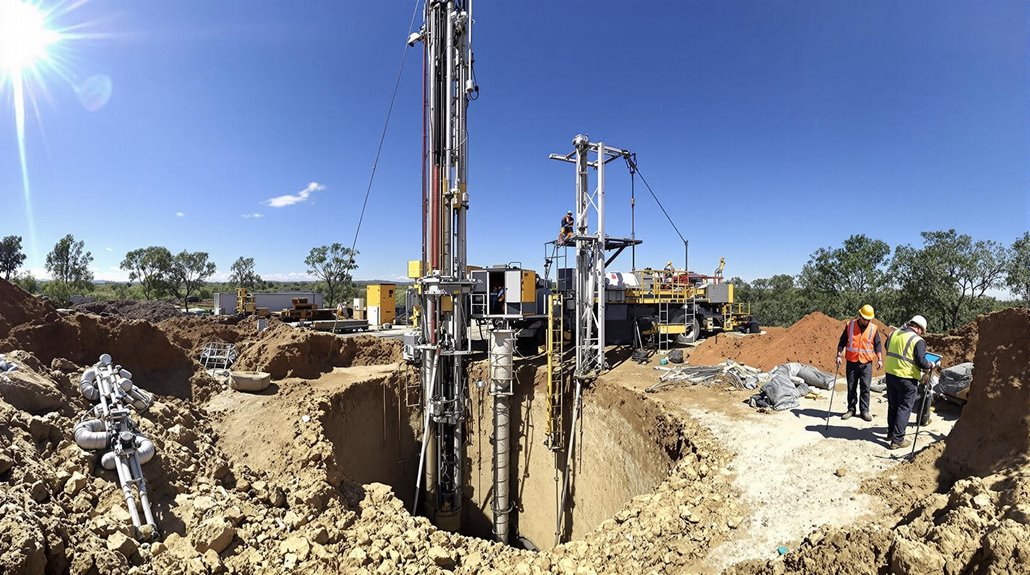When considering a ground source heat pump installation, you'll find borehole depths typically range from 50 to 200 meters. This variation depends on local geological conditions, heat demand, and regulatory guidelines. Geological factors, like soil type and rock formations, can influence drilling feasibility and cost. Deeper boreholes, often exceeding 100 meters, offer more stable temperatures, improving the system's efficiency year-round. Proper vertical spacing between boreholes, usually 5 to 10 meters, is essential to prevent thermal interference. Since local regulations may establish specific depth restrictions, adhering to these guarantees compliance and environmental protection. Uncover more intricacies about this efficient system next.
Determining Borehole Depth
How do you determine the right depth for a borehole when considering a ground source heat pump? First, consider the typical depth range, which is between 50 and 200 meters. This range is influenced by the local geology and the specific heat demand of your property. When planning your installation, deeper boreholes generally offer more stable temperatures throughout the year, which can greatly enhance the efficiency of your heat pump system.
Next, verify proper vertical spacing between boreholes, usually maintained at 5-10 meters. This spacing is vital for efficient heat extraction and to minimize interference between systems, which can otherwise degrade performance. Additionally, local regulations could play an important role in determining the maximum allowable depth for the boreholes. Compliance with these regulations is not just a legal obligation but also fundamental for the safe and effective operation of the system.
Factors Influencing Depth
When determining the depth of a borehole for a ground source heat pump, various factors come into play, and essential among them is the geological composition of the site. The typical depth ranges from 50 to 200 meters, though this can vary based on local conditions and specific heat demand requirements. Deeper boreholes, particularly those exceeding 100 meters, tend to offer more stable temperatures throughout the year, thereby boosting the efficiency of the heat pump system.
You must also consider the vertical spacing between boreholes, which is generally maintained at 5-10 meters. This spacing guarantees ideal heat transfer and prevents interference with adjacent boreholes. Additionally, local regulations can impose restrictions on the maximum depth allowed for boreholes, and these must be strictly followed during installation to guarantee compliance with legal standards.
The geological composition greatly impacts the depth needed, as different materials affect heat extraction capabilities. For instance, some materials may conduct heat better than others, requiring adjustments in borehole depth to enhance performance. By carefully evaluating these factors, you can determine the ideal borehole depth for efficient and effective operation of your ground source heat pump system.
Geological Considerations
Understanding the geological considerations is vital when determining the depth of a borehole for a ground source heat pump. Local geology, including soil type, rock formations, and groundwater levels, plays an important role in this decision. These factors can greatly influence how deep you need to drill to achieve ideal thermal performance. Typically, borehole depths range from 50 to 200 meters. However, if your property has unique geological features, it might require a different depth to guarantee efficiency.
Soil type impacts heat transfer efficiency, as some soils, like clay, have better thermal conductivity than others, such as sandy soils. Rock formations can also affect drilling difficulty and cost, as harder rocks might require specialized equipment. Groundwater levels are another consideration, as they can affect both thermal exchange efficiency and borehole stability.
Furthermore, you must adhere to local regulations that may impose maximum depth restrictions on boreholes. This compliance is essential during planning and installation phases. Additionally, maintaining a vertical spacing of 5-10 meters between multiple boreholes helps prevent thermal interference, assuring efficient operation. By thoroughly analyzing these geological factors, you can enhance the depth and performance of your ground source heat pump system.
Temperature Stability Benefits
Boreholes for ground source heat pumps, typically ranging from 50 to 200 meters in depth, offer remarkable temperature stability benefits. At these depths, geothermal conditions remain consistent year-round, unaffected by seasonal changes. This stability means the heat pump can operate efficiently, as it draws from a reliable temperature source that doesn't fluctuate with external weather conditions. By tapping into these deeper geothermal resources, you guarantee a more efficient heating and cooling system.
Deeper boreholes are particularly advantageous because they access ground temperatures less impacted by surface variability, leading to greater energy efficiency. This efficiency translates into reduced energy consumption and lower operational costs, making them a cost-effective choice in the long run. Additionally, adequate vertical spacing of 5-10 meters between boreholes is vital. This spacing prevents thermal interference, ensuring that each borehole can maintain its temperature stability without affecting neighboring ones.
Local geology also plays a role. In areas with variable surface temperatures, deeper boreholes can provide more consistent performance. By taking these factors into account, you can optimize your ground source heat pump system, achieving not only energy savings but also a reliable, sustainable source of heating and cooling.
Regulatory Depth Guidelines
Maneuvering regulatory depth guidelines is important when planning a ground source heat pump installation. Typically, boreholes range from 50 to 200 meters, but regulations may dictate the maximum depth. These regulations can vary considerably depending on local authorities and geological conditions. Understanding these requirements is essential to guarantee your project complies with all necessary standards.
Before drilling, it's important to check with local authorities to determine any specific depth restrictions that might apply to your area. These rules are usually in place to protect the environment and guarantee safety, so compliance is non-negotiable. Additionally, the depth of your borehole should consider local geology, as deeper boreholes tend to provide more stable temperatures year-round, enhancing efficiency.
When planning multiple boreholes, maintain a vertical spacing of 5 to 10 meters. This spacing prevents thermal interference, optimizing the system's performance. It's critical to integrate these guidelines early in the planning stage to avoid costly adjustments later.


